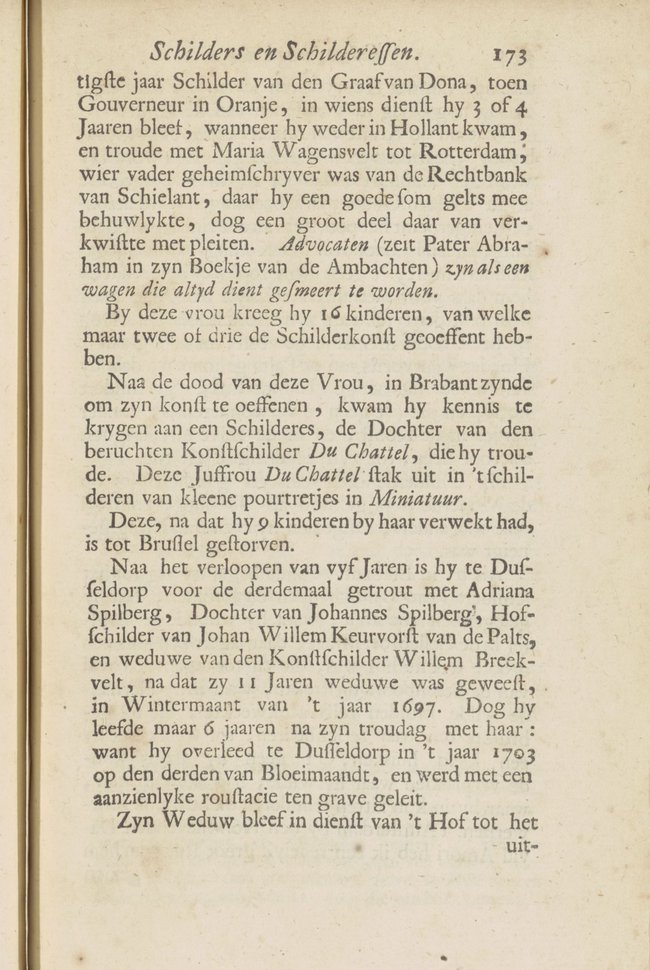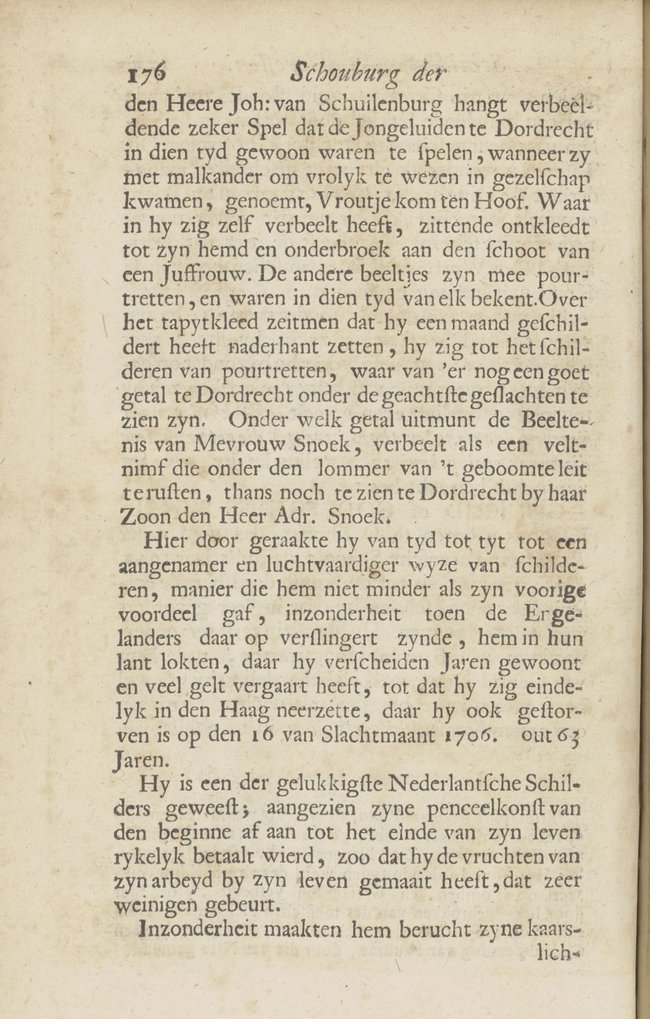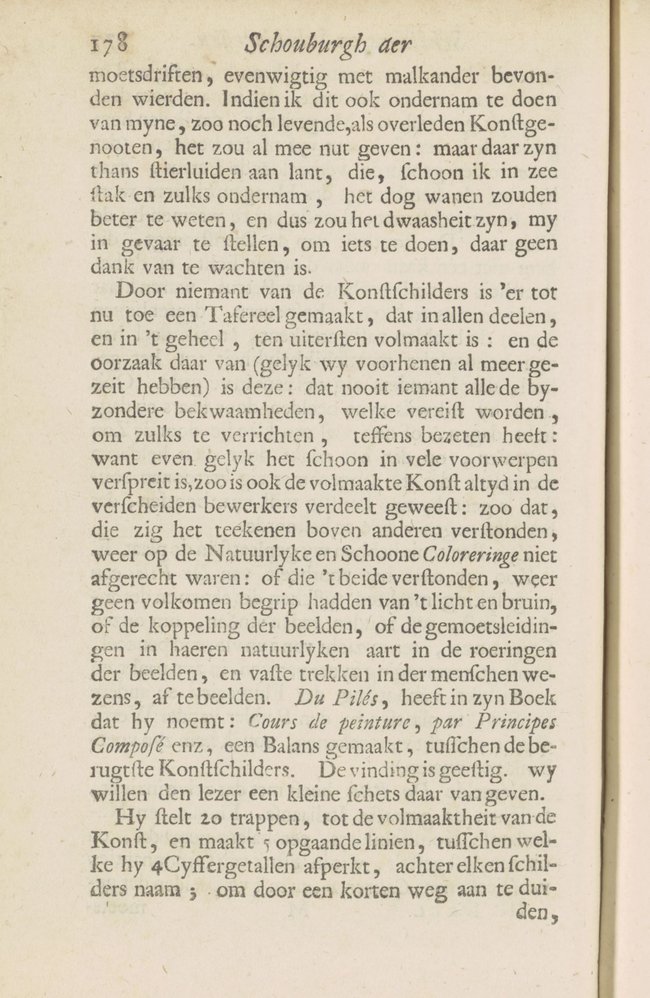Volume 3, page 170-179
Page 170
were the dearest paints. It did not take long before she continued thus: I believe that white is also an expensive pigment? And when I asked after the reason for this belief, I got as answer: Because I see that you use it so sparingly yourself, which caused me to use a little more without comment. Haensbergen also heeded this wonderfully well (as I discerned from many of his portraits), and why not? It is wise to recognize opportunity, on which everything depends, and to help oneself to it, says Mister David van Hoogstraten in his margin notes of page 185 of his Ezopische fabelen van Fedrus, and Augustyn Niphus says of Trogus: He judges that it befits wise people to open the door the moment fortune knocks. For once gone away, she never returns.
I know that the Spanish saying says: Fortune herself pays high interest to those who have the patience to wait her out. But that is not so certain. Jan de Baen (to remain amongst the brotherhood) the famous portrait painter, was sweetly smiled on by Fortune in his time. He let her pass by carelessly, and although he later longed for her, she did not return. One best learns the worth of a thing (say the ancient wise men) by having to do without. But by then it is often too late. Thus the painting youth may take this saying for a fundamental lesson.
Our Haensbergen (to get back to business) had turned from his previous way of practicing art to the painting of portraits. It worked out well (as did the art trade

Page 171
in which he was engaged with Martinus de Jeude, bailiff of the Hague court) and stuck to it to the end of his life.
It does not happen to everyone who attempts such changes in art that the outcome is so fortunate. But lack of ability may also be the cause of this. No one knows his strengths better than a man himself. But without paying attention to this it often happens that when a painter comes by an opportunity to paint a portrait, he undertakes the task because of the profit that tempts him, even though when done, it often resembles the sitter least of all. People in general do not wish to turn away grain from the mill (as the saying goes); that is simply how things go.
A certain Englishman concerned about nothing but painting gilded roses, which one usually sees as decoration for the ceiling of ship cabins, had consumed more in a pub than he could pay for. The innkeeper, who saw no other way of payment, charged him with painting a lion on his sign. The painter, who had no experience with that, advised him that it would be better if he were to paint a rose on it, but the innkeeper did not want to listen to that. When he stayed immovable in his intention to have a lion painted, the painter said, it is very well, j will paint you a Lion, but et shall be als much like a Rose, as you ever see. That is: Very well, I will paint you a Lion, but it will resemble a rose as much as you will ever see.

Page 172
EGLON van der NEER, counsellor and cabinet painter of his Electoral Eminence Johan Wilhelm, was born in Amsterdam in the year 1643. He was the son of Aernout, otherwise known as Aert van der Neer, who in his spring years was a major with the Lords of Arkel. Practicing art in the meantime, he later, when he came to live in Amsterdam, turned entirely to and became famous for the painting of detailed landscapes, especially moonlight scenes.
Eglon, who in his youth was introduced to art by his father, developed inclination to the painting of figures. He was therefore placed in Amsterdam with the commendable painter Jacob van Loo, who excelled in the painting of nude figures, especially women.
The art-loving Mister Nicolaes van Suchtelen, burgomaster of Hoorn, had a large piece by Eglon depicting the bath of Callisto,* which was artfully drawn and painted. I have also seen a female lute player by him which entirely resembled the handling of Johann Liss, both dated 1657.
Having come so far that he could float on his own wings, our Van der Neer left for France to practice his art and in his twentieth
--------
* Callisto, daughter of Lykaon, on whom Jupiter crept up in the guise of Diana, being pregnant was banished by Diana and her group of virgins. The explicators of the unbelievable histories maintain that Callisto hid herself in a bear cave out of shame and was consumed by the bears and that since she never came out but a bear did, the invention that Callisto had been recreated as a bear had found its origin.

Page 173
year became painter to Count Friedrich of Dohna, then governor in Orange, in whose service he remained for 3 or 4 years, when he returned to Holland and married Maria Wagensvelt in Rotterdam. Her father was confidential clerk of the law court of Schieland, so that he also married a goodly sum of money, but he wasted a great deal of it on lawsuits. Lawyers (says Pater Abraham à Sancta Clara in his booklet of Trades) are like a wagon which always needs to be greased.
With this wife he had 16 children, of which only two or three practiced the art of painting.
After the death of his wife, being in Brabant to practice his art, he got to know a paintress, the daughter of the famous painter François Duchatel, whom he married. This Miss Marie Duchatel excelled in the painting of small portraits in miniature.
She died in Brussels after he had engendered 9 children by her.
After the passing of five years he got married for a third time in Düsseldorf in December of 1679 to Adriana Spilberg, daughter of Johann Spilberg II, court painter of Johann Wilhelm Elector Palatine and widow of the painter Willem Breckvelt, after she had been widowed for 11 years. But he lived only 6 years after his wedding day, for he died in Düsseldorf on the 3rd of May 1703 and was laid in his grave with significant funereal pomp.
His widow continued in the service of the court

Page 174
to the last of the Elector’s life. She is currently still occupied with the practice of art.
As far as the art of our Van der Neer is concerned, it deserves to be praised. He was a commendable portrait painter both life-sized and small. Among his depictions is especially praised the portrait of the Princess of Neuburg [1], which he painted at the command of the King of Spain, which so pleased the latter that he not only rewarded him amply but also gave him the title of court painter. However, he was never in Spain but remained until his seventieth year with the court of the Elector Palatine, where he painted several detailed cabinet pieces and that (which is surprising) without decline in his art and in the same detail as before.
He also often painted companies dressed in the modern manner, like Gerard ter Borch II, but sometimes also something different, seeing he was inclined to change.
When he lived in Brabant he turned to the painting of landscapes and herbs, for which he found opportunity since he lived in Brussels in the Cellebroerstraat, where behind his home there was an extended wild courtyard which extended to the wall of the Steenpoort, in which he planted all sort of wild herbs that he used to paint them, to which end he had a small hut made, which he could move anywhere he wanted and in which he could sit painting close to the objects. In Amsterdam, with the art-loving David Amourij I have seen a fairly large work by him,


1
Eglon van der Neer
Portrait of Maria Anna of Neuburg, future queen of Spain (1667-1740), 1689
Munich, Alte Pinakothek, inv./cat.nr. 5647
Page 175
in which Ceres was depicted, searching with a burning torch in cliffs and caverns for her abducted daughter Proserpina [2].* This scene is painted in wonderful detail, especially the thistles, small herbs, and trunk of a tree overgrown with ivy, but it is a little on the sharp side because of this detail. He had the honour of having had Adriaen van der Werff, the Rotterdam phoenix in art, as his student.
He was exceptionally diligent and his intellect, ever at work, always sought out the beautiful and lasting paints, to which he was exceptionally attached. But tired of searching any longer he said to his students, do not search for paints; there are now enough that are good. Learn to use them well, which lesson he applied to his own contentment.
GODFRIED or GODEFRIDUS SCHALCKEN was born in the year 1643 in Dordrecht, where his father was principle of the Latin school.
His affection for art had him say farewell to the practice of languages, in which he was already far advanced. He first turned to the instruction of Samuel van Hoogstraten and later to Gerard Dou, whose handling he was able to imitate quite well, as may still be seen in one of his art works, which hangs in the cabinet of
--------
* Proserpina was abducted by Pluto while she was busy gathering flowers in her lap, and taken to his subterranean realm. See the 5th book of the 4th chapter of Ovid’s Metamorphoses. In ancient times this subject was often depicted on tombs and grave stones to indicate the tearing out of the human soul from the body. One also sees it depicted on a commemorative medal of Faustina, minted by those of Niza.


2
Eglon van der Neer
Circe punishes Glaucus by turning Scylla into a monster, dated 1695
Amsterdam, Rijksmuseum, inv./cat.nr. SK-A-4874
Page 176
Mister Johan van Schuylenburch [3]. It depicts a certain game called little woman come a courting that the young people of Dordrecht were wont to play at that time when they came together in company to be jolly. In it he depicted himself, sitting undressed down to his shirt and underpants in the lap of a damsel. The other figures are also portraits and were known to everyone at the time. It is said that he worked a month on the carpet hanging. He later applied himself to the painting of portraits, of which there are still a goodly number with the most esteemed families of Dordrecht. Among this number excels a portrait of Mrs. Snouck depicted as a field nymph resting beneath the foliage of trees, now still to be seen in Dordrecht with her son Mister Adriaen Snouck [4].
This way he arrived from time to time at a more pleasant and lighter way of painting which brought him no less profit than his preceding one, especially when the English, being addicted to it, tempted him to their land, where he lived several years and amassed a lot of money until he at last settled in The Hague, where he also died on the 16th of November 1706.
He was one of the happiest of Dutch painters, seeing that the art of his brush was amply paid from the beginning to the end of his life, so that he reaped the rewards of his labours while alive, which occurs but very rarely .
He especially owed his fame to his candlelight


3
Godefridus Schalcken
The game ´Lady come into the garden´, c. 1670
London (England), Royal Collection - Buckingham Palace, inv./cat.nr. RCIN 405343

4
Godefridus Schalcken
Portrait of Elisabeth Talliarde (1654-1689) as a nymph, second half 1680s
Middelburg (city, Zeeland), Zeeuws Museum, inv./cat.nr. M 62-100

Page 177
scenes, which he was able to paint so naturally and powerfully that I do not know if anyone was his equal in them. I recall that I saw a piece by him with about five or six figures (which happened only rarely) depicting Peter when he is challenged by the maid servant of the high priest [5]. The boldness of the maid servant, who shines a candle into his eyes, and the hesitancy and shyness of Peter, could clearly be discerned in the facial features. In addition, the figures were firmly drawn and every part had its proper relationship to the whole, a matter in which he otherwise sometimes erred. Also, he often had his figures loom up through candle- or daylight, or lit by the sun through a cloth, so that the flesh might reveal itself more pleasantly through the clear reflection, which he was able to do so skilfully that it flattered and charmed the eyes of everyone.
We have placed his portrait in Plate G.
If we were to follow the example of Roger de Piles and compare one artist to another, we would find reason to place Schalcken with the knight Van der Werff with respect to his flattering brush, the artful mixing of his colours, his nudes and natural imitation of velvet and other fabrics, but with respect to his drawing I would assign him his foot stool.
Armed with that same insight mentioned De Piles has made up the balance between the greatest Italian, French and Netherlandish painters and composed a list of who in the matter of ordinance, drawing, colouring and the depictions of the


5
Godefridus Schalcken
Peter Denouncing Christ, c. 1700-1706
Private collection
Page 178
passions are comparable to each other. If I were to do this for my living and deceased fellow artist, that would also be useful, but there are now helmsmen on land who, if I were to head out to sea and undertake it, would still think they know better. And thus it would be folly to put myself in danger by doing something for which no gratitude is to be expected.
None of the painters has made a scene which is completely perfect in all respects and the reason (as we have more often said before) is this, that no one has possessed all the specific accomplishments that are needed to achieve this. For just as the beautiful is spread out amongst many objects, so the perfect art work had always been divided between various workers so that those who understood drawing better than others were not attuned to natural and beautiful colours, or that those who understood both did not have a complete concept of light and dark, or the coupling of figures, or depict the passions in the movement of figures and fixed expressions in human features. In the book that he calls Cours du peinture, par Principes Composé etc, De Piles has drawn up a balance between the most famous painters. The find is amusing. We want to give the reader a brief sketch of it.
He proposes 20 steps to perfection in art and makes 5 vertical lines between which he encloses 4 figures after each painter’s name to indicate by a short route

Page 179
in which part of art the one is equal to, or different from the other, and writes the figures above each of the columns as follows:
Composition, Drawing, Colour, Expression
Raphael 17, 18, 12, 18
Rubens 18, 13, 17, 17
Titian 12, 15, 18, 6
Rembrandt 15, 6, 17, 12
Van Dyck 15, 10, 17, 13
Poussin 15, 17, 61, 5
In the line of composition Raphael stands on the 17th step, for his draughtsmanship on the 18th, for colour on the 12th and for his natural expression of the passions on the 19th step.
In the category of composition Rubens is one step higher than Raphael, for drawing 5 steps lower, for colour 5 steps lower and for the expression of the passions, 5 steps.
In the category of composition Poussin is the equal of Rembrandt and Van Dyck, but in the category of the passions as low as Rembrandt for drawing [sic].
GOVERT van der LEEUW, otherwise known as De Lione, was born in Dordrecht on the 11th of November 1643. His father, Bastiaan Govertz. van der Leeuw, was a handsome painter of oxen, cows, sheep etc. and pupil of Jacob Gerritz. Cuyp, but later exchanged the brush


